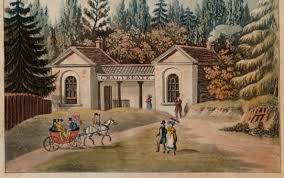 Moniker/Name: tkh
Moniker/Name: tkh
Source of Question: Research
Your Question: One more question for you. I’ve been looking into “taking the waters.” Everyone speaks of Bath, but I ran across a reference that said the aristocracy was advised in the Regency period that bathing in the sea was actually better than taking the waters in Bath. Which meant bathing (dipping), as was done at Brighton. Also, different springs had very different mineral contents (depending obviously on the types of rocks they sprang from or washed down through), and so the different springs were said to be healing or healthful for different conditions.
Yet I have seen no references talk about traveling to other mineral baths. One reference claims that England has only one mineral spring (Bath); but other say England has several, Wales has one, and Ireland has many. Yet I never see references of the aristocracy traveling to Ireland or Wales to take the waters at this or that spring. Across the channel, Vichy is famous, but there are dozens of other mineral springs in France. There are even more in Germany. Hungary has Eger, Gelliert Hill, etc. And Italy, Spain, etc.
So… If someone wasn’t getting well, would they just return to their country house to decline, or travel to other parts of the UK or the continent to take the waters at a better, more healing spring? And if they traveled, would they dare France (how unfortunate to be seen as a French sympathizer, even for Vichy!), or head for Italy or some other country instead?
For Part I of this answer, specifically about taking the waters and drinking vs dipping, see this post.
The A guide to all the watering and sea-bathing places (1813) has a comprehensive list of many sea-bathing and “watering” places of wellness to visit as well as blurbs about each place that describe amenities and qualities that may or may not recommend it as a “fashionable resort”. Its clear from this text, as well as several other guidebooks from the era, that there was an audience for these types of travel guides for the health seeker. This had its origins from previous centuries (Collinge) and (Stobart) and would continue on well into the next century.
Guidebooks and more modern academic research are our main sources for gleaning the health seekers pilgrimages throughout the UK. Similarly, there are guidebooks which tout the hot springs and mineral amenities of places in continental Europe and substantial academic research that points to spa tourism.
As far as first hand sources, I have seen more references to visiting foreign places for the climate’s impact on health than to partake in mineral cures, but I don’t doubt that there were instances where someone might move to Italy for the weather and also avail themselves of hot springs, sea bathing or other cures.
Below are some snippets that suggest wellness tourism was very much a thing in the Regency UK:
From The Monthly Magazine (1817) Vol 44. “Leamington Spa has been unusually full of company of the most distinguished families.”
About Builth Wells in Wales:
The Cyclopædia: Or, Universal Dictionary of Arts, Sciences, and Literature (1819)
About Moffat in Scotland: The Traveller’s Guide Through Scotland (1814)
I have actually read quite a bit on many of the spa towns for research, and my educated guess would be you might chose a location based on a variety of factors and depending on your condition. Cost, closeness to friends/family/home, recommendations of Drs. or others, attractions, accommodations…all of this may factor in to where an invalid chose to visit to recuperate. Its my impression that many of those seeking cures would stay in one place for some time to feel the benefits, or seasonally. But its not outside to imagine, if one was well enough to travel, that a wellness seeker may try multiple locations over the course of years. But as travel typically involved not an insignificant amount of planning/uncomfortable journeys I would doubt someone popping by several of the Spa towns in one season.
I am certainly no expert and welcome other perspectives on this topic!
A medical dictionary (1819) that details different Dr.’s work on sea or cold bathing: https://books.google.com/books?id=mcIwAQAAMAAJ&dq=medical&pg=PA234#v=onepage&q=bathing&f=false
Bacon, W. (1998) Economic Systems and Their Impact on Tourist Resort Development: The Case of the Spa in Europe”. Tourism Economics.
Blackbourn, D. (2002). “Fashionable spa towns in nineteenth-century Europe.” Water, Leisure and Culture. Oxford: Berg.
Collinge, P. (2017). “I swim like a frog that has lost the use of its hind legs’: The Pursuit of Health and Leisure in Buxton, 1781-90”. Journal for Eighteenth Century Studies.
Stobart, J (2000) “In Search of a Leisure Hierachy: English Spa Towns and their Place in Eighteenth-Century Urban System” from New Directions in Urban History. New York: Waxmann.











